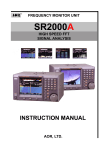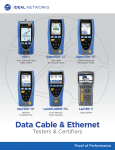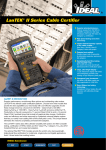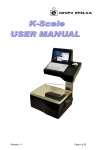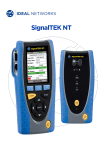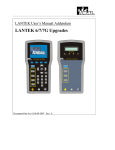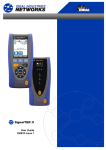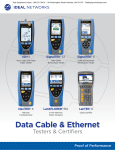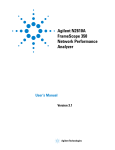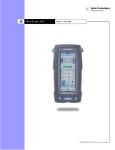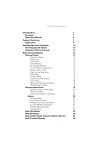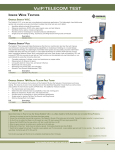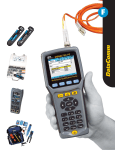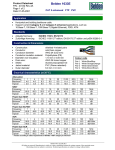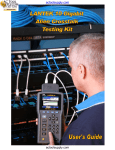Download LanTEK - ideal industries
Transcript
®
LanTEK III
COPYRIGHT NOTICE
The information contained in this document is the property of IDEAL INDUSTRIES Ltd. and
is supplied without liability for errors and omissions. No part of this document may be
reproduced or used except as authorized by contract or other written permission from
IDEAL INDUSTRIES Ltd. The copyright and all restrictions on reproduction and use apply
to all media in which this information may be placed.
IDEAL INDUSTRIES Ltd. pursues a policy of continual product improvement and reserves
the right to alter without notice the specification, design, price or conditions of supply of
any product or service.
© IDEAL INDUSTRIES LTD. 2015
All rights reserved
Publication ref: 161809
Issue 1 - 11/2015
(Applies to software revision 3.050 onwards)
IDEAL INDUSTRIES LTD.
Stokenchurch House
Oxford Road
Stokenchurch
High Wycombe
Buckinghamshire
HP14 3SX UK
www.idealnetworks.net
Safety Precautions
Exercise caution when handling rechargeable batteries (accumulators)
All lithium-ion battery packs (Li-ion), regardless of their indicated charge state, are capable
of producing electrical current sufficient to cause personal injury and/or property damage.
Do not dispose of lithium-ion battery packs (Li-ion) in a fire or with regular waste. Lithiumion battery packs (Li-ion) may explode if exposed to open flame. The battery packs are
hazardous waste and may contaminate ground water sources if disposed of in landfills.
IDEAL INDUSTRIES, LTD. tries to provide the maximum protection possible by installing an
automatic reset fuse in the battery packs, to help stop high current discharge as quickly as
possible. However, these fuses may not completely protect against a momentary arc
discharge, which can result if the battery pack's electrical contacts are shorted. The
following battery pack handling precautions must be closely followed to avoid risk of injury.
•
•
•
•
•
•
•
•
When a battery pack is not installed in the Display (DH) or Remote (RH) handset, it
should be kept in a clean, dry, non-conductive package.
Keep conductive materials away from the battery pack at all times.
Keep contact sides of the battery pack away from each other at all times.
Battery packs can be charged while in the Display (DH) and in the Remote (RH)
handset, but also externally with the adapter. Charging in any other manner may
cause the battery pack to explode.
Always install, remove, store, and charge the battery packs in a non-explosive
atmosphere.
Observe operating and storage temperatures (see chapter 1.3. Dimensions, Weights,
Operating Conditions).
Do not allow children or persons unfamiliar with the precautionary instructions in
this manual to handle or recharge the battery packs.
Do not open the battery pack case. There are no user-serviceable parts inside the
case, and the batteries in the case are not replaceable.
LanTEK III
User Manual
161809 Iss 1
Page2
Disclaimer
IDEAL INDUSTRIES, LTD. does not assume any liability for death, injury or damage to
equipment or property resulting from improper use of the battery packs.
IDEAL INDUSTRIES, LTD. will not be liable for consequential damages that may result from
tampering with the battery packs or charger or their use thereafter.
Subject to technical changes.
Environmental Protection
If you have any questions concerning these precautions, the operating instructions, or any
other concerns about the safe use and disposal of the battery packs used in LanTEK®III,
please contact a representative of IDEAL INDUSTRIES, LTD. For contact information, please
refer to Chapter Customer Service.
Using the 161®III Cable Certifier
All cable parameter default settings programmed in the LanTEK®III Cable Certifier are based
on generic standards, proposed industry recommendations for cables and network links,
the latest technical information available from International LAN cabling standards
committees, the LAN industry, and IDEAL INDUSTRIES' own experience and testing.
Before performing any measurements, IDEAL INDUSTRIES, LTD. recommends to request
detailed information from contractor or project manager on the standards to be used for
measuring, to ensure that relevant parameters are complied with.
Information on the use of this Instruction Manual
The following symbols used in this manual indicate that the user should exercise particular
caution in order to prevent personal injury or damage to the LanTEK®III Cable Certifier or
the system under test.
WARNING!
This symbol indicates potentially lethal voltages. The life and/or health of the person
performing the activity or anybody in the vicinity is at risk.
CAUTION!
This symbol indicates that the relative activity could possibly harm the environment or
damage technical equipment.
NOTE:
Here you will find general notes, additional information, or support.
Typographical Conventions
•
•
•
Boldface Refers to a button on LanTEK®III Cable Certifier.
Italics Refers to a menu option in this Operating Manual.
Quotation marks " " Identifies a "Screen Message".
LanTEK III
User Manual
161809 Iss 1
Page3
CONTENTS
Chapter 1. Your LanTEK III Cable Certifier ................................................................................ 6
1.1
Technical Information...........................................................................................................................6
1.2
Product Specifications ......................................................................................................................... 7
1.3
Dimensions, Weights, Operating Conditions ............................................................................. 7
1.4
Performance Specifications ...............................................................................................................8
Chapter 2. Product Description ................................................................................................... 9
2.1
The Display Handset (DH) ..................................................................................................................9
2.1.1
Controls and Ports/Connectors ..................................................................................................9
2.1.2
TFT Display ......................................................................................................................................... 11
2.1.3
Function Keys F1 to F10 ............................................................................................................... 12
2.1.4 Soft Key ............................................................................................................................................... 12
2.2
The Remote Handset (RH) ............................................................................................................... 13
2.2.1
Controls and Ports/Connectors ................................................................................................ 13
2.3
Power Management ............................................................................................................................ 15
2.3.1
Operating the Display and Remote handset from AC Power ...................................... 15
2.3.2 Battery Charging ............................................................................................................................. 16
2.4
Talkset ....................................................................................................................................................... 16
Chapter 3. Basics of the Cable Test ........................................................................................... 17
3.1
Testing of cables and relevant requirements .......................................................................... 17
3.1.1
Setup for Permanent Link Test ................................................................................................. 17
3.1.2
Setup for Channel Link Test ....................................................................................................... 18
3.1.3
Setup for other Test Methods.................................................................................................... 18
Chapter 4. Preferences ................................................................................................................. 19
4.1
Open Preferences ................................................................................................................................ 19
4.2
User Information ................................................................................................................................... 19
4.3
Autotest Options ................................................................................................................................. 20
4.4
Contrast .................................................................................................................................................... 21
4.5
Timeout Options ................................................................................................................................... 21
4.6
Measurement Units ............................................................................................................................. 22
4.7
Talkset ...................................................................................................................................................... 22
4.8
Date and Time ...................................................................................................................................... 23
4.9
Restore Default .................................................................................................................................... 24
4.10
Clear Memory ........................................................................................................................................ 24
4.11
Temperature .......................................................................................................................................... 25
Chapter 5. Autotest ..................................................................................................................... 26
5.1
Set Autotest Pref................................................................................................................................. 27
5.2
Select Job Folder ................................................................................................................................ 28
5.2.1
Enable Existing Job Folder ........................................................................................................ 28
5.2.2 Create New Job Folder ............................................................................................................... 29
5.3
Set Cable Name (cable ID).............................................................................................................. 30
5.3.1
Simple Cable ID ................................................................................................................................ 31
5.3.2 Default Cable ID .............................................................................................................................. 33
5.4
Labeling Standard TIA/EIA 606-A .............................................................................................. 35
5.4.1 Cable Name in Format TIA/EIA 606A .................................................................................. 36
5.4.2 Cable Parameter 606A Drop .................................................................................................... 36
5.4.3 Cable Parameter 606A Backbone .......................................................................................... 37
5.4.4 Cable Parameter 606A Backbone Pair/Fiber .................................................................... 37
5.5
Select Twisted Pair Cabling ............................................................................................................ 38
5.5.1
Specify Cable Type ....................................................................................................................... 39
5.5.2 Create Cable Type ......................................................................................................................... 39
5.5.3 Edit and Calculate NVP ............................................................................................................... 42
5.5.4 Enter Reference Temperature .................................................................................................. 43
5.6
DualMODE™ Function for Twisted Pair Cabling..................................................................... 44
5.6.1
Implement DualMODE™ ............................................................................................................... 44
5.7
Edit NVP Default Value of a Cable .............................................................................................. 46
5.8
Coaxial Cable Standards .................................................................................................................. 47
LanTEK III
User Manual
161809 Iss 1
Page4
5.8.1
Autotest Test Series for Coaxial Cables ............................................................................... 48
5.9
Calibration .............................................................................................................................................. 48
5.9.1
Twisted Pair Cabling ..................................................................................................................... 48
5.9.2 Coaxial Cable ................................................................................................................................... 50
5.10
Perform Autotest ................................................................................................................................ 52
5.11
Open Job Folder of Autotest......................................................................................................... 52
5.11.1
Job Options ................................................................................................................................. 53
5.11.2
Test Options ................................................................................................................................ 54
5.11.3
Copy Job Folder to USB Removable Storage .............................................................. 54
5.11.4
Alien Crosstalk Measurements (AXT) .............................................................................. 54
5.12
Autotest Results and Graphs ......................................................................................................... 55
5.12.1
Graph Formats, Layouts and Controls ............................................................................. 56
Chapter 6. Structured Cabling Testing ..................................................................................... 58
6.1
Test Setup for Single Test Analysis ............................................................................................. 58
6.2
Test Run of Single Test Analysis .................................................................................................. 58
6.3
Perform Single Test Analysis ......................................................................................................... 58
6.4
Evaluation of Analysis Test Results............................................................................................. 59
6.4.1 Graphs for Analysis Tests ........................................................................................................... 59
6.5
Overview of Single Test Analysis .................................................................................................60
6.6
Wiremap Test .......................................................................................................................................60
6.7
Length Test ............................................................................................................................................. 61
6.7.1
Length Test Error ............................................................................................................................ 61
6.8
Resistance Test ..................................................................................................................................... 61
6.8.1 Resistance Test Error ................................................................................................................... 62
6.9
NEXT, ACR-F (ELFEXT) and Power Sum ................................................................................. 62
6.10
Power Sum NEXT, Power Sum ACR-F (ELFEXT) ................................................................. 63
6.10.1
NEXT Test and ACR-F (Power Sum ELFEXT) Test Error ........................................ 64
6.11
Insertion Loss Test (Attenuation) ................................................................................................ 64
6.11.1
Insertion Loss test Error ......................................................................................................... 64
6.12
Return Loss Test .................................................................................................................................. 64
6.12.1
Return Loss Test Error ............................................................................................................ 65
6.13
Impedance Test ................................................................................................................................... 65
6.13.1
Impedance Error ........................................................................................................................ 65
6.14
Delay and Skew Test ......................................................................................................................... 66
6.14.1
Delay and Skew Test Error ................................................................................................... 66
6.15
Capacitance Test ................................................................................................................................. 66
6.15.1
Capacitance Test Error ........................................................................................................... 67
6.16
ACR-N (ACR) Test and Power Sum ACR-N (Power Sum ACR) Test ........................... 67
6.16.1
ACR-N (ACR) Test and Power Sum ACR-N (Power Sum ACR) Test Error ..... 67
6.16.2
Troubleshooting ACR-N (ACR) Test and Power Sum ACR-N (Power Sum
ACR) Test Error ............................................................................................................................................. 67
6.17
Headroom Test..................................................................................................................................... 67
6.17.1
Headroom Test Error ............................................................................................................... 68
6.18
Custom Cable Preferences and Cable Parameters ............................................................... 68
6.18.1
Creating a New Custom Cable Type................................................................................. 68
6.18.2
Select Custom Cable Type .................................................................................................... 69
6.18.3
Custom Cable Parameters..................................................................................................... 70
Chapter 7. Coaxial Cable Test ..................................................................................................... 71
7.1
Properties of Coaxial Cables ........................................................................................................... 71
7.2
Troubleshooting Coaxial Cables .................................................................................................... 71
Chapter 8. Tone Generator ......................................................................................................... 72
8.1.1
Enable Tone Generator with Display handset (DH) ........................................................ 72
8.1.2
Enable Tone Generator with Remote handset (RH) ....................................................... 72
Chapter 9. LanTEK Firmware Upgrade ..................................................................................... 74
9.1
Perform Firmware Upgrade............................................................................................................ 74
9.1.1
Using the Computer ...................................................................................................................... 74
9.1.2
Firmware Upgrade with USB Removable Storage .......................................................... 75
Chapter 10. Customer Service ................................................................................................. 76
LanTEK III
User Manual
161809 Iss 1
Page5
Chapter 1. Your LanTEK III Cable Certifier
The LanTEK®III Cable Certifier is designed to measure twisted pair cables (TP), coaxial
cables and fiber-optic cables used for high-speed data transmission in communications
networks.
1.1
Technical Information
Features
LanTEK®III-500
LanTEK®III-1000
Frequency range
500 MHz
1000 MHz
Cable specification CAT 3/ISO C,
CAT 5/ISO D, 5e/D new, 6/E
Cable specification CAT 6A/ISO EA
Cable specification ISO F, ISO FA
Upgradeable
Accuracy level III / IIIe / IV
(LanTEK III)
IIIe (ETL)
IIIe / IV (ETL)
DualMODE™-tests
1700
1700
Optional
Optional
Lithium-ion battery packs
Wireless connection to IDEAL
AnyWARE™ app
external dongle
external dongle
®
Permanent Link test with patch
cord for non RJ45 connectors
Permanent Link test with
permanent link adaptor for RJ45
connectors
CAT 6 test storage capacity with
graphs
USB port
Serial port (concerns only
Service)
Fiber (LWL) loss and length
measurement (FiberTEK™ FDX )
Communication over fiber (LWL)
and copper (Full Duplex)
LCD-display on Remote handset
(RH)
Tone generator to determine
connection on near and remote
end
LanTEK III
User Manual
161809 Iss 1
Page6
1.2
Product Specifications
Standard Test Compliance
ANSI/TIA/EIA 568A, 568B, 568-C2 CAT 6A/6/5E/3, ISO FA/F/EA/D/C, AS/NZS 3080, IEEE
802.3 Ethernet, EN50173 – FA/F/E/D/C
Cable Types
UTP/SCTP/FTP CAT 3/5E/6A/7/7A (100 Ω); Coax (50/75 Ω)
1.3
Dimensions, Weights, Operating Conditions
Dimensions:
(L) 254 mm x (W) 127 mm x (D) 53 mm
Weights:
Display handset (DH)
Remote handset (RH)
Battery pack
1180 g (incl. battery)
1120 g (incl. battery pack)
548 g
Battery Packs Display Handset (DH) and Remote Handset (RH):
Lithium-ion battery packs (Li-ion)
Operating life with Battery Pack:
18 hours under normal conditions
Charging Time:
In handset
6-8 hours
External
4 hours
Operating Temperature (min/max):
o
o
0 C to +50 C (Operate only if handset temperature is close to ambient temperature!)
Storage Temperature (min/max):
o
o
-20 C to +70 C
Relative Humidity:
5% to 90%, noncondensing
LanTEK III
User Manual
161809 Iss 1
Page7
1.4
Performance Specifications
LanTEK®III
Length (50 - 100 Ωcable)
Range
0 – 605 m
Resolution
0.1 m
Accuracy
+ (3 % + 1 m)
Delay
0 - 8000 ns
1 ns/0.1 m
+ (3 % + 1 ns)
Average impedance
35 – 180
0,1
+ (3 % + 1 )
Capacitance (bulk)
0 - 100 nF
+ (2 % + 20 pF)
Capacitance
0 - 333 pF/m
1 pF or 3
digits
0.1 pF
DC loop resistance
35 -200
0,1
+ (1 % + 2 )
Attenuation
1 MHz - 1 GHz
0.1 dB
Level III/IIIe/IV
NEXT (crosstalk)
1 MHz - 1 GHz
0.1 dB
Level III/IIIe/IV
Return loss
1 MHz - 1 GHz
0.1 dB
Level III/IIIe/IV
ELFEXT / ACR-F
1 MHz – 1 GHz
0.1 dB
Level III/IIIe/IV
ACR / ACR-N
1 MHz – 1 GHz
0.1 dB
Level III/IIIe/IV
LanTEK III
User Manual
+ (2 % +1 pF)
161809 Iss 1
Page8
Chapter 2. Product Description
2.1
The Display Handset (DH)
The Display handset (DH) ensures control of preferences and test functions during
individual cable tests.
2.1.1
Controls and Ports/Connectors
9
10
12
8
11
7
6
13
5
4
3
2
1
Fig. 1 The Display Handset (DH) Front view
Controls
Description
1
On/Off
Power the Display handset (DH) on/off.
2
Dim Backlight
Dim Backlight in two stages.
3
Shift
Toggle key activities having dual functions.
4
Help / Language
Open Help Menu / Open Language Selection
5
Talk / Call RH
6
Length / Analyze
7
Wiremap / File
LanTEK III
User Manual
Activate Talkset function / call Remote Handset
(RH).
Open Length Measurement / Open Diagnostics
Menu.
Open analyze function "Wiremap" / Open Job
List.
161809 Iss 1
Page9
Controls
Description
8
Autotest
9
TFT-Display
10
Function keys
F1 to F5 / F6 to F10
11
Arrow Keys / Enter
12
Escape
13
Alphanumeric Keys
Direct execution of test run pre-programmed
for established standards.
Display of menus, test results, graphs, activity
selection and function keys.
Select menu options displayed on screen.
Navigate menus on TFT Display / Enter key to
activate and edit the selected menu.
Abort and exit the current menu without
making changes.
Enter numbers, letters and special characters.
14
15
16
17
18
19
Fig. 2 The Display Handset (DH) Rear and side view
Ports/Connectors
Description
14
Low-NEXT-Connector
Connect a test adapter.
15
Service and Maintenance Jack
Connection for service and maintenance work.
16
USB Port
Connect USB removable devices to transmit
data and to load Firmware-Updates.
17
USB Device
Connect to a computer
18
Talkset Jack
Connect a Talkset.
19
DC Input Jack
Connect an external power supply and charge
battery pack.
LanTEK III
User Manual
161809 Iss 1
Page10
2.1.2
TFT Display
Ready screen appears on operational Display handset (DH).
1
2
3
18
17
16
15
4
5
6
14
7
13
8
12
11
10
9
Fig. 3 TFT Display
Display
Description
1
Power supply and charge
state
Indicates battery operation or external power supply and
charge state of battery pack (%).
2
Talkset indicator
Indicates whether talkset function is active.
3
Screen Title
Indicates that display handset (DH) or selected function
is ready.
4
Time and Date
Displays the time and date.
5
Field calibration
Select the field calibration.
6
Preferences
Select the instrument preferences.
7
Toner
Select the tone generator.
8
General Help
Select the Help menu.
9
Cable Type
Select or edit the cable type.
10
Fiber
Select the fiber measurement.
11
Analyze
Perform individual cable tests in real time.
12
Instrument
Display the information on LanTEK III Cable Certifier.
13
Function Name
Displays the name of highlighted function.
14
Cable ID
Select cable naming function.
15
Stored Tests
Select file manager for the stored tests.
16
Job Name
Display the current job name.
17
Test Standard
Display the cable type selected for tests.
18
Records
Number of records stored.
LanTEK III
User Manual
®
161809 Iss 1
Page11
2.1.3
Function Keys F1 to F10
Function keys F1 to F5 have dual functions (F6 to F10). Pressing down the Shift key while
simultaneously pressing one of the function keys F1 to F5 will activate the 2nd function of
the function key (example: Shift + F4 equals function F8).
2.1.4
Soft Key
Soft keys indicate possible menu options at the bottom of the screen. To select the
according option, press the corresponding Function Key (F1 - F5) below the soft key.
The example below shows the setting of Timeout options by using the soft keys at the
bottom of the screen. The Value is set by Function Keys F1 (Increase) and F2 (Decrease).
Softkeys
Function keys
Fig. 4 Soft keys and function keys
LanTEK III
User Manual
161809 Iss 1
Page12
2.2
The Remote Handset (RH)
The Remote handset (RH) works with the Display handset (DH) to perform autotests or
individual real time analyze tests. The Remote handset (RH) is located at the end of the
cable link and communicates with the Display handset (DH). To perform measurements, the
Remote handset (RH) is automatically activated by the Display handset (DH).
2.2.1
Controls and Ports/Connectors
10
9
11
8
12
7
6
5
4
3
2
1
Fig. 5 The Remote Handset (RH) Front view
Controls
Description
1
On/Off
Power the Remote handset (RH) on/off.
2
Dim Backlight
Dim Backlight in two stages.
3
Shift
Toggle key activities having dual functions.
4
Talk / Call DH
Activate Talkset function / call Remote handset
(RH).
5
Tone / Tone Mode
Power the tone generator on/off.
6
Escape
Abort and exit the current action without making
changes.
7
Autotest
Start the Autotest.
8
Pass LED
Test result: Passed.
LanTEK III
User Manual
161809 Iss 1
Page13
Controls
Description
Hazard LED
Excessive line voltage (TELCO): Excessive
voltage at measurement input.
10
S/W-LCD Display
Two line alphanumeric display
11
On LED
The Remote Handset is on.
12
Fail LED
Test result: Fail.
9
13
14
15
16
17
Fig. 6 The Remote Handset (RH) Rear and side view
Ports/Connectors
Description
13
Low-NEXT-Connector
Connect a test adapter.
14
Service and Maintenance Jack
Connection for service and maintenance work.
15
USB Device
Connect to a computer for firmware updates.
16
Talkset Jack
Connect a Talkset.
17
DC Input Jack
Connect an external power supply and charge
battery pack.
LanTEK III
User Manual
161809 Iss 1
Page14
2.3
Power Management
Both the Display (DH) and Remote (RH) handset use interchangeable rechargeable lithiumion battery packs (Li-ion).
•
•
•
•
The Display (DH) and Remote (RH) handsets can be run on battery power for
approximately 18 hours. Actual battery power times depends on various factors,
such as operating time versus standby time, use of the display backlight, and
ambient temperature.
When charge state of battery drops below the required voltage, a warning appears.
Tester automatically shuts down before testing results are affected.
To save battery power, the Display (DH) and Remote (RH) handset automatically
power down after a certain period of inactivity.
If the instrument will not be used for a prolonged time it is recommended that the
battery protection strips be inserted to conserve battery charge.
2.3.1
Operating the Display and Remote handset from AC Power
The Display (DH) and Remote (RH) handset can also be operated from an external DC
source (AC/DC adapter). The adapters are universally applicable.
Fig. 7 Adapter for LanTEK III DH and RH
When using the AC/DC adapter to power the handsets, please note that:
•
•
Both handset batteries will receive a trickle charge.
A power plug will appear in the upper left corner of the Display handset (DH).
CAUTION!
Only the adapter provided with the instrument shall be used. Other types of adapters
may cause damage to the tester.
NOTE:
Do not connect to AC power when testing shielded cables, as this may result in ground
loops which in turn can cause input protection warnings.
LanTEK III
User Manual
161809 Iss 1
Page15
2.3.2
Battery Charging
The batteries of the Display (DH) and Remote (RH) handset are charged using the adapter.
It takes approximately 6-8 hours until the batteries in the instrument are fully charged. If the
batteries are charged externally, charge time is approximately 4 hours.
During recharging, the instrument is calibrated to the corresponding battery. This ensures
an accurate indication of the charge state at all times.
NOTE:
Charge time depends on charge state of battery.
When the battery is removed, the Display handset (DH) data and preferences are preserved
in the flash ROM by a coin cell lithium battery.
2.4
Talkset
The LanTEK III Cable Certifier is designed for use with a talkset. This function allows
communication between the Display (DH) and Remote (RH) handset through an externally
attached microphone/headset. For this purpose, the Display (DH) and Remote (RH)
handset must be connected to the test adapters through a cable.
®
LanTEK III
User Manual
161809 Iss 1
Page16
Chapter 3. Basics of the Cable Test
3.1
Testing of cables and relevant requirements
The following sections describe typical setup for permanent link and channel link testing.
Fig. 8 Illustration of test setup
The area marked with P indicates the typical test setup of a Permanent Link.
The area marked with C indicates the typical test setup of a Channel Link.
3.1.1
Setup for Permanent Link Test
The standards ANSI, EIA, TIA and ISO all differentiate between permanent link and channel
link on specifications for testing of communication networks. A permanent link consists of
up to 90 meters of horizontal cabling. (Maximum length limit applies to TIA standards only.)
The permanent link shown above serves to certify the installation of the horizontal cabling
before network connection and user hook-up. Adapters, patch cords and jumpers are
excluded from testing.
Depending on the link under test, Permanent Link testing with LanTEKIII requires different
adaptors:
• All RJ-45 cabling systems:
R161051
Permanent Link Adaptor
R161050
•
PL Adaptor Replacement Tips
All non-45 cabling systems:
R161056
LanTEK® GG45-Adaptor
R161054
LanTEK® TERA-Adaptor
R161055
LanTEK® EC7-Adaptor
NOTE:
LanTEK III
User Manual
Please visit www.idealnetworks.net for an
up to date full list of test adaptors.
161809 Iss 1
Page17
3.1.2
Setup for Channel Link Test
A channel link includes all components of a cabling system. It consists of up to 90 meters
horizontal cabling, including patch cords, jumpers, and test adapters at each cable end. The
channel link shown above serves to certify the network installation, including the horizontal
cable line and patch cord.
Channel link testing requires different test adaptors depending on the link under test:
R161056
LanTEK® GG45-Adaptor
R161054
LanTEK® TERA-Adaptor
R161055
LanTEK® EC7-Adaptor
R161053
LanTEK® Cat. 6A-Adaptor for RJ-45
R161052
LanTEK® Cat. 6-Adaptor for RJ-45
NOTE:
3.1.3
Please visit www.idealnetworks.net for an
up to date full list of test adaptors.
Setup for other Test Methods
Depending on the testing requirements other than permanent link and channel, LanTEKIII
offers various testing configurations:
•
Coaxial testing
R161057
LanTEK® Coax-Kit
• Testing of End-to-End (E2E) , Device- or Direct Attach Links:
R160050
LanTEK® Industrial Ethernet Kit
& R161053
& LanTEK® Cat. 6A-Adaptor for RJ-45
(both adaptors are required)
NOTE:
LanTEK III
User Manual
Please visit www.idealnetworks.net for an
up to date full list of test adaptors.
161809 Iss 1
Page18
Chapter 4. Preferences
Most instrument configurations are set by using the "Preferences" menu.
4.1
Open Preferences
1.
Use Arrow Keys to navigate to "Preferences" and press Enter.
Fig. 9 Open Preferences
2. Next, the instrument preferences can be set by using the listed menus.
Fig. 10 Preference Selection
4.2
User Information
This menu can be used to provide information on assigned Technician, Company and
Contractor.
1.
Use Arrow Keys to navigate to "User Information" menu and press Enter.
LanTEK III
User Manual
161809 Iss 1
Page19
Fig. 11 User Information
2. Use Arrow Keys to navigate to desired option Name, Company or Contractor.
3. Use Alphanumeric Keys to enter the desired information.
4. Make corrections to entries by using the soft keys
(delete at cursor
position),
(delete characters to the left of cursor),
/
(insert alphanumeric characters at cursor position / overwrite highlighted entry).
5. Press Enter to save the information entered. Press Escape to exit the menu without
making changes.
4.3
Autotest Options
Use this menu to set Autotest options.
1.
Use Arrow Keys to navigate to "Autotest Options" menu and press Enter.
Fig. 12 Autotest Options
2. Use Arrow keys to select the desired option.
3. Use soft key
to activate or deactivate the selected option. An activated
option is indicated by the green box.
4. Press Enter to save the information entered. Press Escape to exit the menu without
making changes.
LanTEK III
User Manual
161809 Iss 1
Page20
4.4
Contrast
Use this menu to set Dim Backlight on screen.
1.
Use Arrow Keys to navigate to "Contrast" menu and press Enter.
Fig. 13 Contrast
2.
Use soft keys
to set backlight intensity.
3.
Press Enter to save the information entered. Press Escape to exit the menu without
making changes.
4.5
Timeout Options
Use this menu to set the time after which backlight automatically dims and the LanTEK®III
Cable Certifier automatically shuts down when tester is not in use.
Default settings:
Backlight
Tester
1.
1 minute
30 minutes
Use Arrow Keys to navigate to "Timeout Options" menu and press Enter.
Fig. 14 Timeout Options
2. Use Arrow keys to select the desired option.
3. Use soft keys
LanTEK III
User Manual
to set the desired value.
161809 Iss 1
Page21
4. Press Enter to save the information entered. Press Escape to exit the menu without
making changes
4.6
Measurement Units
Use this menu to specify the measurement unit for length measurements ft or m (foot or
meter). The default setting depends on the language selected.
1. Use Arrow Keys to navigate to "Measurement Units" menu and press Enter.
Fig. 15 Measurement Units
2. Use soft key
/
(foot / meter) to select the desired unit.
3. Press Enter to save the information entered. Press Escape to exit the menu without
making changes.
4.7
Talkset
Use this menu to set signal strength of tone generator, volume of internal speaker and
volume of talkset. Also use this menu to change the talkset mode.
1.
Use Arrow Keys to navigate to "Talkset" menu and press Enter.
Fig. 16 Talkset
2. Use Arrow Keys to select the desired option.
LanTEK III
User Manual
161809 Iss 1
Page22
3. On options Toner Volume, Speaker Volume or Talkset Volume, use soft keys
to set signal strength and volume.
4. Press Enter to save the information entered. Press Escape to exit the menu without
making changes.
4.8
Date and Time
Accurate date and time settings are important for the reliable identification of records and
test reports.
1.
Use Arrow Keys to navigate to "Date and Time" menu and press Enter.
Fig. 17 Date and Time
2. Use soft key
/
to set the desired Time format.
3. Use Arrow Keys to navigate to option Time.
4. Use Alphanumeric Keys to enter the time.
5. Use Arrow Keys to navigate to option Date Format.
6. Use soft keys
to select the desired format MDY
(month/day/year), DMY (day/month/year) or YMD (year/month/day).
7. Use Arrow Keys to navigate to option Date.
8. Use Alphanumeric Keys to enter the date.
9. Use Arrow Keys to navigate to option Date/Time Display.
10. Use soft key
/
to select the desired setting.
11. Press Enter to save the information entered. Press Escape to exit the menu without
making changes.
LanTEK III
User Manual
161809 Iss 1
Page23
4.9
Restore Default
Use this menu to reset all tester settings to their factory defaults. Using this option will not
delete stored tests.
1.
Use Arrow Keys to navigate to "Restore Defaults" menu and press Enter.
Fig. 18 Restore Defaults
2. Use the soft key
to accept default settings.
3. Use the soft key
to exit the screen without making changes.
4.10
Clear Memory
Use this menu to clear all records from the tester memory at one time.
CAUTION!
When using the "Clear Memory" menu, the records cannot be restored. This will permanently delete
all stored tests.
1.
Use Arrow Keys to navigate to Clear Memory menu and press Enter.
Fig. 19 Clear Memory
2. Use the soft key
to clear the memory of the Cable Certifier.
3. Use the soft key
to exit the screen without making changes.
LanTEK III
User Manual
161809 Iss 1
Page24
4.11
Temperature
Use this menu to select the required temperature in Celsius or Fahrenheit.
1.
Use Arrow Keys to navigate to "Temperature" menu and press Enter.
Fig. 20 Temperature
2. Use the soft keys
to select the desired temperature.
3. Press Enter to save the information entered. Escape allows you to exit the menu
without making changes.
LanTEK III
User Manual
161809 Iss 1
Page25
Chapter 5. Autotest
Using Autotest, the installation can be measured and tested in a simple and fast way. After
pressing the AUTOTEST key, LanTEK III Cable Tester automatically performs a number of
pre-programmed single tests. Autotest can be enabled from the Display (DH) or Remote
(RH) handset.
®
Selection of single tests from the test series depends on the type of cabling to be tested.
Specification of the test series is based on approved or recommended standards, as well as
specific parameters.
After the test series is completed, LanTEK III Cable Tester displays an overall passed/failed
result, as well as the individual passed/failed results.
®
Preferences on Display handset (DH)
•
•
•
•
Set Autotest Pref.
Select job folder.
Set cable name (cable ID).
Select cable type.
Connections
•
•
Separate cable line to be tested from all network components.
Using suitable patch cords, connect the Display handset (DH) to one end of the
cable line (link), and the Remote handset (RH) to the opposite end of the cable line
(link).
Test run
By pressing the AUTOTEST key, the test procedures described below are initiated:
•
•
First, the Display handset (DH) attempts to establish a connection to the Remote
handset (RH) via a correctly connected wire pair. If connection cannot be
established, the Display handset (DH) will show the message "Searching for Remote
(RH). The search is continued until the Autotest is manually cancelled or the Remote
handset (RH) is located.
After connection to the Remote handset (RH) has been successfully established, its
serial number is read out to check if current configuration data are available.
NOTE:
If during the last 7 days no calibration has been performed on the identified Remote
handset (RH), the Autotest is cancelled and the user receives a message that a field
calibration is required.
•
•
•
•
Display handset (DH) continues the Autotest if serial number is valid. Most Autotests
start with the Wiremap test for twisted pair cables.
Following the Wiremap test, the other single tests that have been defined for the
currently selected cable type are performed.
After completion of Autotest, all test data can be displayed, saved and printed.
The test results of the last Autotest are stored in the non-volatile memory and
remain available for viewing even after the LanTEK III Cable Tester is powered on or
powered down.
The test results of the last Autotest remain in the non-volatile memory until they are
overwritten by new test results, the memory is deleted or an analysis test is
conducted.
®
•
LanTEK III
User Manual
161809 Iss 1
Page26
Overall Passed/Failed Result
The overall result of Autotest is displayed after test series is completed.
Symbol
Overall Autotest Result
The overall Autotest receives a passing grade if all single tests have been passed
or passed*.
The overall Autotest receives a failing grade if at least one single test has failed or
failed*.
5.1
Set Autotest Pref
1.
Open "Preferences" on start screen.
2. In "Preferences" open Autotest Pref.
3. Use Arrow Keys to navigate to the according Autotest Pref. Use soft key
to enable or disable the selected Autotest Pref. Enabled Autotest Pref are indicated
by green boxes.
Fig. 21 Autotest Pref
4. Press Enter to save the information entered. Escape allows you to exit the menu
without making changes.
Autotest Pref
Description
Simple cable ID
Assign name to cable line and set/reset meter reading of tests. The
name can be assigned as simple cable ID or double cable ID (Cable
From/Cable To).
NOTE:
If Simple Cable ID is not enabled, the cable name assigned will be
the default cable ID. In addition to cable name and test meter, an
initial value and a final value can be set, and the way of counting
can be specified.
Stop on Fail
Autosave
Auto Increment
This will permanently
delete the Tests / Jobs
from the tester
LanTEK III
User Manual
The Autotest is stopped after the first failed test.
The LanTEK III Cable Tester automatically names and saves all
results of passed Autotests in the current job folder.
The test meter for the cable ID is automatically advanced after each
Autotest.
®
Enables confirmation prompt prior to deleting data.
161809 Iss 1
Page27
Autotest Pref
Description
Enable 606A
Enable labelling standard TIA/EIA 606-A for telecommunication
infrastructure as cable ID.
NOTE:
If labelling standard TIA/EIA 606-A is enabled; the selected cable
name (simple cable ID/default cable ID) is not applied.
In case of failed Autotest, it determines whether another fault
analysis will automatically be performed.
Enable Wiremap On
Failed Autotest.
5.2
Select Job Folder
The name of the current job folder is shown in the TFT display on the ready screen. To save
the Autotest it is possible to keep this job folder, enable another existing job folder, or
create a new job folder.
5.2.1
1.
Enable Existing Job Folder
Use Arrow keys to navigate to "File" and press Enter to open the job list.
Fig. 22 File
2. Use Arrow Keys to navigate to the desired job folder. The display is highlighted blue.
LanTEK III
User Manual
161809 Iss 1
Page28
Fig. 23 Job List
3. Use soft key
to open job options.
4. Use Arrow Keys to navigate to option Make Job Current. The display is highlighted
blue.
Fig. 24 Job Options (example Current Job Info)
5. Press Enter to save the information entered. Escape allows you to exit the menu
without making changes.
6. When confirming with Enter, the name of the selected job folder will appear on the
ready screen.
5.2.2
1.
Create New Job Folder
Use soft key
to open job options in job list.
Fig. 25 Job List
LanTEK III
User Manual
161809 Iss 1
Page29
Use Arrow Keys to navigate to option New Job and press Enter.
Fig. 26 Job Options
Use Alphanumeric Keys to enter the desired information.
Fig. 27 New Job
Make corrections to entries by using the soft keys
(delete at cursor position),
(delete characters to the left of cursor),
/
(insert
alphanumeric characters at cursor position / overwrite highlighted entry).
Press Enter to save the information entered. Escape allows you to exit the menu without
making changes.
When confirming with Enter, the name of the new job folder will appear on the ready
screen.
5.3
Set Cable Name (cable ID)
The cable name of the cable lines in an Autotest consists of a fixed Cable Name and a
variable Current Value (4-digit test meter) that automatically increments. Depending on
selected Autotest Pref it is also possible to specify structure and way of counting.
1.
Use Arrow keys to navigate to "Cable ID" and press Enter.
LanTEK III
User Manual
161809 Iss 1
Page30
Fig. 28 Cable ID
The name used last will appear:
•
Single Cable ID (1 name is assigned to each cable).
or
•
Double Cable ID (2 names are assigned to each cable, one for the start and one
for the end of the cable).
Fig. 29 Cable ID
•
Increment… when pressing Enter, the current value of the test meter, shown in
view below, is incremented by one position.
•
Set… opens menu for cable name.
•
Select… switches between Single Cable ID and Double Cable ID.
5.3.1
Simple Cable ID
2. Use Arrow keys to navigate in "Cable ID" view to option Set… and press Enter.
Single Cable ID (1 cable name)
3. Use Alphanumeric Keys to enter a Cable Name for the test portion.
4. Use Alphanumeric Keys to reset the Current Value of the test meter, or enter an
arbitrary value.
5. Make corrections to entries by using the soft keys
(delete at cursor
position),
(delete characters to the left of cursor),
/
(insert alphanumeric characters at cursor position / overwrite highlighted entry).
LanTEK III
User Manual
161809 Iss 1
Page31
Fig. 30 Single Cable ID
6. Press Enter to save the information entered. Escape allows you to exit the menu
without making changes.
Double Cable ID (2 cable names, start/end)
7. Use Alphanumeric Keys to enter a Cable Name for the Cable From/Cable To of
test portion.
8. Use Alphanumeric Keys to reset the Current Value of the test meter, or enter an
arbitrary value.
9. Make corrections to entries by using the soft keys
(delete at cursor
position),
(delete characters to the left of cursor),
/
(insert alphanumeric characters at cursor position / overwrite highlighted entry).
Fig. 31 Double Cable ID
10. Use soft keys
and Cable To.
and
to switch between the views Cable From
11. Use Alphanumeric Keys to enter a Cable Name for the Cable From/Cable To of
test portion.
12. Use Alphanumeric Keys to reset the Current Value of the test meter, or enter an
arbitrary value.
LanTEK III
User Manual
161809 Iss 1
Page32
13. Make corrections to entries by using the soft keys
(delete at cursor
position),
(delete characters to the left of cursor),
/
(insert alphanumeric characters at cursor position / overwrite highlighted entry).
14. Press Enter to save the information entered. Escape allows you to exit the menu
without making changes.
5.3.2
Default Cable ID
Simple cable ID was not selected in Autotest Pref.
1.
Use Arrow keys to navigate in "Cable ID" view to option Set… and press Enter.
Simple Cable ID (1 cable name)
2. Use Alphanumeric Keys to enter a Cable Name for the test portion.
3. Use Alphanumeric Keys to reset the Current Value of the test meter, or enter an
arbitrary value.
4. Use Alphanumeric Keys to enter an arbitrary value for Start and End. Meter is
reset after reaching final value.
5. Make corrections to entries by using the soft keys
(delete at cursor
position),
(delete characters to the left of cursor),
/
(insert alphanumeric characters at cursor position / overwrite highlighted entry).
6. Use symbol
to lock a position into entered value. Use symbol
Auto Increment of a character.
to enable
Fig. 32 Single Cable ID
7. Press Enter to save the information entered. Escape allows you to exit the menu
without making changes.
Double Cable ID (2 cable names, start/end)
1.
Use Alphanumeric Keys to enter a Cable Name for the Cable From/Cable To of
test portion.
2. Use Alphanumeric Keys to reset the Current Value of the test meter, or enter an
arbitrary value.
3. Use Alphanumeric Keys to enter an arbitrary value for Start and End. Meter is
reset after reaching final value.
LanTEK III
User Manual
161809 Iss 1
Page33
4. Make corrections to entries by using the soft keys
(delete at cursor
position),
(delete characters to the left of cursor),
/
(insert alphanumeric characters at cursor position / overwrite highlighted entry).
5. Use symbol
to lock a position into entered value. Use symbol
Auto Increment of a character.
to enable
Fig. 33 Double Cable ID
6. Use soft keys
and Cable To.
and
to switch between the views Cable From
7. Use Alphanumeric Keys to enter a Cable Name for the Cable From/Cable To of
test portion.
8. Use Alphanumeric Keys to reset the Current Value of the test meter, or enter an
arbitrary value.
9. Use Alphanumeric Keys to enter an arbitrary value for Start and End. Meter is
reset after reaching final value.
10. Make corrections to entries by using the soft keys
(delete at cursor
position),
(delete characters to the left of cursor),
/
(insert alphanumeric characters at cursor position / overwrite highlighted entry).
11. Use symbol
to lock a position into entered value. Use symbol
Auto Increment of a character.
to enable
12. Press Enter to save the information entered. Escape allows you to exit the menu
without making changes.
Examples for Default Cable ID
In default setting, the meter starts at 0000 and ends at 9999. The four (4) positions are
enabled and incrementing.
Default
Example 1
Example 2
Example 3
"Cable From"
Cable name:
TEST
Current: 0 0 0 0
Start:
0000
End: 9 9 9 9
0 0 0 0
LanTEK III
User Manual
Cable name:
PANEL 1
Current: 0 0 0 0
Start:
0000
End:
0022
0 0 0 0
Cable name:
PANEL 2
Current: 0 1 8 A
Start:
0 0 0 A
End:
0 9 9 D
0 1 8 A
"Cable To"
Cable name:
OFFICE 2
Current: 0 0 0 0
Start:
0 0 0 0
End:
9 9 9 9
Cable name:
Distributor
Current:0 0 0 A
Start: 0 0 0 A
End:
0 0 9 D
0 0 0 0
0 0 0 A
161809 Iss 1
Page34
0 0 0 1
0 0 0 1
0 1 8 B
0 0 0 1
0 0 0 B
0 0 0 2
0 0 0 2
0 1 8 C
0 0 0 2
0 0 0 C
0 0 0 3
0 0 1 0
0 1 8 D
0 0 0 3
0 0 0 D
0 0 0 4
0 0 1 1
0 1 9 A
0 0 0 4
0 0 1 A
0 0 0 5
0 0 1 2
0 1 9 B
0 0 0 5
0 0 1 B
0 0 0 6
0 0 2 0
0 1 9 C
0 0 0 6
0 0 1 C
0 0 0 7
0 0 2 1
0 1 9 D
0 0 0 7
0 0 1 D
0 0 0 8
0 0 2 2
0 2 0 A
0 0 0 8
0 0 2 A
0 0 0 9
0 0 0 0
0 2 0 B
0 0 0 9
0 0 2 B
0 0 1 0
0 0 0 1
0 2 0 C
0 0 1 0
0 0 2 C
0 0 1 1
0 0 0 2
0 2 0 D
0 0 1 1
0 0 2 D
0 0 1 2
0 0 1 0
0 2 1 A
0 0 1 2
0 0 3 A
5.4
Labeling Standard TIA/EIA 606-A
The standards TIA/EIA 606-A for telecommunication infrastructure include the following
elements:
•
Horizontal cable arrangements and cabling.
•
Backbone cable arrangements and cabling.
•
Grounding/potential equalization for telecommunication systems.
•
Rooms (e.g. service connection room, telecommunication room, equipment Room
and fire protection installations.)
The mentioned standards affect the administration of telecommunication infrastructure by:
•
Assigning identifiers to infrastructure components.
•
Specifying information elements on which the infrastructure is based.
•
Specifying the relation between these records to ensure the contents.
•
Specifying reports that contain information on record groups and
•
Specifying the requirements on graphs and symbols.
LanTEK III
User Manual
161809 Iss 1
Page35
5.4.1
Cable Name in Format TIA/EIA 606A
To determine cable name, a structure for the test portion is created. The three (3) cable
parameters 606A Drop, 606A Backbone and 606A Backbone Pair/Fiber are available.
1.
Use Arrow keys to navigate to "Cable ID" and press Enter.
Fig. 34 Cable ID
5.4.2
Cable Parameter 606A Drop
Name of horizontal cable line (e.g. 1 building, 1 floor, 1 distribution, sockets)
2. Use soft key Drop to select cable parameter 606A Drop.
Fig. 35 Cable Parameter 606A Drop
AAA
A
Floor
Telecom room
-
AA
0000
Panel
Port
3. Use Left/Right Arrow Keys to navigate to desired position in port area. Use
Up/Down Arrow Keys to assign characters and numbers.
4. Proceed in the same manner with positions Panel, Telecom Room and Floor.
5. Use soft key
to hide individual positions. Assembling the cable line
automatically generates the 606A-Name.
6. Press Enter to save the cable name. Use Escape to exit menu without making
changes.
LanTEK III
User Manual
161809 Iss 1
Page36
5.4.3
Cable Parameter 606A Backbone
Name of a horizontal and vertical cable line (e.g. several floors, several distributions,
sockets).
8. Use soft key Backbone to select cable parameter 606A Backbone.
Fig. 36 Cable Parameter 606A Backbone
AA
A
/
Floor
Telecom room
AAA
A
Floor
Telecom room
-
00
Port
9. Use Left/Right Arrow Keys to navigate to desired position in port area. Use
Up/Down Arrow Keys to assign characters and numbers.
10. Proceed in the same manner with positions Telecom Room and Floor.
11. Use soft key
to hide individual positions. Assembling the cable line
automatically generates the 606A-Name.
12. Press Enter to save the cable name. Use Escape to exit menu without making
changes.
5.4.4
Cable Parameter 606A Backbone Pair/Fiber
Name of a horizontal and vertical cable line with a pair/fiber connection (e.g. building,
several floors, several distributions, sockets).
1.
Use soft key
to select cable parameter 606A Backbone Pair/Fiber.
Fig. 37 Cable Parameter 606A Backbone
Pair/Fiber
LanTEK III
User Manual
161809 Iss 1
Page37
AAA
A
Floor
Telecom room
/
AAA
A
Floor
Telecom room
-
00
Port
.
000
Pair
2. Use Left/Right Arrow Keys to navigate to desired position in Pair area. Use
Up/Down Arrow Keys to assign characters and numbers.
3. Proceed in the same manner with positions Port, Telecom Room, and Floor.
4. Proceed in the same manner with positions Telecom Room and Floor.
5. Use soft key
to hide individual positions. Assembling the cable line
automatically generates the 606A-Name.
6. Press Enter to save the information entered. Escape allows you to exit the menu
without making changes.
5.5
Select Twisted Pair Cabling
1.
Open "Cable Type" on start screen.
2. Use Arrow Keys to navigate to installation type of cable line to be tested
(Twisted Pair Perm, Twisted Pair Basic or Twisted Pair Channel) and confirm with
Enter.
Fig. 38 Cable Type
3. Use Arrow Keys to navigate to desired cable type.
Fig. 39 Example Twisted Pair Perm
4. Press Enter to save the information entered. Escape allows you to exit the menu
without making changes.
Or
LanTEK III
User Manual
161809 Iss 1
Page38
5. Use available soft key options to specify a cable type, create a cable type, edit
NVP values or enter reference temperature.
5.5.1
1.
Specify Cable Type
Use soft key
to open select menu to specify the selected cable type.
2. Use Arrow keys to navigate to desired specification and confirm with Enter.
Fig. 40 Specification of Cable Type
3. Press Enter to save the information entered. Escape allows you to exit the menu
without making changes.
5.5.2
1.
Create Cable Type
Use soft key
type.
to open select menu for individual creation of a cable
2. Use Arrow keys in Select Menu to navigate to option Frequency Range and
confirm with Enter.
Fig. 41 Select Menu
3. Use Arrow Keys to navigate to the individual boxes and use Alphanumeric Keys
to assign start and stop frequencies for Certification and Performance Range.
LanTEK III
User Manual
161809 Iss 1
Page39
Fig. 42 Frequency Range
4. Press Enter to save the information entered. Escape allows you to exit the menu
without making changes.
5. Use Arrow keys in Select Menu to navigate to option Connector Pinout and
confirm with Enter.
6. Use Arrow keys to navigate to desired pairings and enable or disable your
selection with soft key
box.
. An enabled pairing is indicated by the green
Fig. 43 Connector Pinout
7. Press Enter to save the information entered. Escape allows you to exit the menu
without making changes.
8. Use Arrow keys in Select Menu to navigate to option Test Limits and confirm
with Enter.
9. Use Arrow keys to navigate to the individual boxes and assign desired limit with
the Alphanumeric Keys.
Fig. 44 Test Limits
LanTEK III
User Manual
161809 Iss 1
Page40
10. Press Enter to save the information entered. Escape allows you to exit the menu
without making changes.
11. Use Arrow keys in Select Menu to navigate to option Link Models and confirm
with Enter.
12. Use soft key
Rate, Ignore or Skip.
to select the link model Perm, Basic, Channel, EIA, Flat
Fig. 45 Link Models
13. Use Arrow Keys to navigate to the individual boxes and use Alphanumeric Keys
to assign the values for NEXT, Insertion Loss, Return Loss and ACR-F (ELFEXT).
14. Press Enter to save the information entered. Escape allows you to exit the menu
without making changes.
15. Use Arrow keys in Select Menu to navigate to option Select Autotest and
confirm with Enter.
16. Prepare the desired measuring modes for the Autotest by using Arrow Keys to
navigate to the desired measuring modes. Enable or disable your selection with
soft key
. An enabled measuring mode is indicated by the green box.
Fig. 46 Select Autotests
17. Press Enter to save the information entered. Escape allows you to exit the menu
without making changes.
18. Use Arrow keys in Select Menu to navigate to option Custom Name/NVP and
confirm with Enter.
19. Use Alphanumeric Keys to assign a name for the created cable type.
20. Make corrections to entries by using the soft keys
(delete at cursor
position),
(delete characters to the left of cursor),
/
(insert alphanumeric characters at cursor position / overwrite highlighted entry).
LanTEK III
User Manual
161809 Iss 1
Page41
Fig. 47 Custom Name/NVP
21. Use Arrow keys to navigate to the individual boxes and assign desired NVP with
the Alphanumeric Keys.
22. Press Enter to save the information entered. Escape allows you to exit the menu
without making changes.
5.5.3
1.
Edit and Calculate NVP
Use soft key
to open Select Menu for editing and calculating NVP.
2. Use Arrow keys to navigate to the individual boxes and assign desired NVP with
the Alphanumeric Keys.
Fig. 48 NVP
3. Use soft key
to open menu for entering cable length.
4. Use Arrow Keys to navigate to box and use Alphanumeric Keys to assign Cable
Length (m).
5. Connect cable to be tested.
LanTEK III
User Manual
161809 Iss 1
Page42
Fig. 49 Cable Length
6. Use soft key
to start calculation of NVP.
7. Press Enter to save NVP. Use Escape to exit menu without making changes.
5.5.4
1.
Enter Reference Temperature
Use soft key
to open Select Menu for changing ambient temperature.
2. Use Alphanumeric Keys to assign reference temperature.
Fig. 50 Reference Temperature
3. Press Enter to save the reference temperature. Use Escape to exit menu without
making changes.
LanTEK III
User Manual
161809 Iss 1
Page43
5.6
DualMODE™ Function for Twisted Pair Cabling
The DualMODE™ function of LanTEK III Cable tester allows measurement in compliance with
2 limits in one single Autotest. Thus, for instance, simultaneous Channel Link and Permanent
Link measurements can be performed.
®
With DualMODE™ it is possible to perform other important tests. Let us assume you are
installing a Cat-6 system in a country whose government agency uses a national standard
based on ISO. But you are working with cables and connection components manufactured
by a company in the US. The government agency can request a certification according to
ISO Class E from the installer. However, for warranty reasons the US company might insist
on TIA 568 Category 6. Therefore, in the past both certifications were required - in
compliance with ISO and TIA - and the increased costs had to be passed on to the
customer. In contrast, DualMODE™ makes it possible to perform both certifications at the
same time, in compliance with ISO Class E Permanent Link and TIA 568B Category 6. The
costs are the same as for one test.
Another example for the use of DualMODE™ is the calculation of margins in relation to
higher bandwidth for future applications. Up to now you had to check the certification
documents for Category 6 Permanent Link and assess whether adequate margins for
transmission of applications at higher bandwidth are available. However, assessment of the
complete final data would also require a certification according to Category 6A. Due to
higher test costs, these measures would usually not be performed.
With DualMODE™ you can certify the system in compliance with Category 6, and perform
tests with the limits of Category 6A. Due to unmistakable data, your customer would know
exactly what cable lines support higher bandwidths in future applications. This information
would be of great importance when making a decision on whether to assemble cables with
connectors of a higher category, or to pull in cables of a higher category.
5.6.1
1.
Implement DualMODE™
Open "Cable Type" on start screen.
2. Use Arrow Keys to navigate to function Twisted Pair DualMODE™ and confirm
with Enter .
Fig. 51 Twisted Pair DualMODE™
3. Use Arrow Keys to navigate to desired cable types. Use soft key
to
enable, and soft key Deselect All to disable your selection. An enabled pairing is
indicated by the green box.
4. If you would like another link model, or edit and calculate NVP for the
DualMODE™ pairing, press Shift.
LanTEK III
User Manual
161809 Iss 1
Page44
5. Press AUTOTEST. The passed/failed results are displayed. For each DualMODE™
test, the worst case margins and values for NEXT, RL, ACR und Loss are
indicated.
Fig. 52 Overall DualMODE™ Result
6. Use Enter to load the corresponding graphical result displays of the highlighted
test.
LanTEK III
User Manual
161809 Iss 1
Page45
5.7
Edit NVP Default Value of a Cable
To perform length measurement, the nominal velocity of propagation (NVP) of the cable
must be known. This value can be found in the technical cable information. If this
information is not available, a cable of known length (ca. 30 – 60 meter) should be
connected, and the NVP calculated by LanTEK III Cable Tester.
®
1.
Open "Cable Type" on start screen.
2. Use Arrow Keys to navigate to desired cable type.
Fig. 53 NVP Default Value
3. Use soft key
to open menu for entering NVP.
Fig. 54 Enter NVP
4. Use Alphanumeric keys to enter one or several NVP.
5. For automatic calculation of a new NVP, press
.
Fig. 55 Calculation of NVP
LanTEK III
User Manual
161809 Iss 1
Page46
6. Connect a cable of known length.
7. Use Arrow Keys and Number Keys to enter known cable length.
8. For automatic calculation of a new NVP, press
NVP, the display returns to the NVP main screen.
. After calculation of new
NOTE:
This concerns a channel measurement. When entering the cable length, the length of both
patch cords must be considered.
5.8
Coaxial Cable Standards
The LanTEK III Cable Tester supports the following coaxial cable standards:
®
CATV standards
Ethernet standards
Other cable types
RG59 31 or 92 m
(3-fold or 4-fold shield)
10Base 2
IBM Coax
RG6 31 or 92 m
(3-fold or 4-fold shield)
10Base 5
TWINAXIAL
ARCNET
1.
Open "Cable Type" on start screen.
2. Use Arrow Keys to navigate to option Ethernet and confirm with Enter.
Fig. 56 Ethernet
3. Use Arrow Keys to navigate to desired cable type and confirm with Enter.
Fig. 57 Cable Type
LanTEK III
User Manual
161809 Iss 1
Page47
5.8.1
Cable Types
Autotest Test Series for Coaxial Cables
Resistance
Length
Loss
Return loss
Impedance
RG59 31 or 92 m
X
X
X
X
X
RG6 31 or 92 m
X
X
X
X
X
IBM Coax
X
X
X
TWINAX, ARCNET
X
X
X
10BASE2
(IEEE 802.3)
X
X
X
10BASE5
(IEEE 802.3)
X
X
X
5.9
Calibration
A field calibration must be performed if:
•
During the last 7 days no calibration has been performed. The user receives a
message, informing him that a field calibration is required.
•
The test adapter has been changed.
•
A patch cord has been changed.
•
Note that field calibration is not necessary for CAT6A Permanent Link adaptors.
5.9.1
1.
Twisted Pair Cabling
Use Arrow Keys to navigate to "Calibration" and press Enter to open job list.
Fig. 58 Ready screen
Calibration requires one patch cord each for the Display handset (DH) and the Remote
handset (RH).
NOTE:
It is imperative not to mix up the corresponding patch cords for Display handset (DH) and
Remote handset (RH), and they must also be used for the cable test. We recommend to
mark the patch cords accordingly.
LanTEK III
User Manual
161809 Iss 1
Page48
13. Connect Display handset (DH) and Remote handset (RH) with patch cord for
Remote handset (RH), as shown on the display. Remember which connection
of the patch cord is connected to the Remote handset (RH).
Fig. 59 Patch Cord (RH)
14. Use soft key
to initiate calibration. The Remote handset (RH) indicates
calibration, and a progress bar shows the status.
15. Connect Display handset (DH) and Remote handset (RH) with patch cord for
Display handset (DH), as shown on the display. Remember which connection of
the patch cord is connected to the Display handset (DH).
Fig. 60 Patch Cord (DH)
16. Use soft key
to continue calibration. The Remote handset (RH)
indicates calibration, and a progress bar shows the status.
17. Perform the same patch cord connections to Display handset (DH) and Remote
handset (RH) as during the previous test steps.
Fig. 61 Open Patch Cord
LanTEK III
User Manual
161809 Iss 1
Page49
18. On Display handset (DH) use soft key
calibration.
to start the last step of
19. On Remote handset (RH) use Autotest to start the last step of calibration.
Fig. 62 Calibration Complete
20. On Display handset (DH) press Escape to return to screen. The Remote handset
(RH) briefly displays that calibration was successful, and then shows ready state.
5.9.2
Coaxial Cable
Calibration must be performed if:
•
During the last 7 days no calibration has been performed. The user receives a
message, informing him that a field calibration is required.
•
The test adapter has been changed.
•
A patch cord has been changed.
For calibration with COAX adapters, the LanTEK III process, consisting of 4 steps, is
changed. Since the coaxial cables are tested at low frequencies, the additional data
received during calibration are largely ignored, thus calibration with LanTEK III Cable Tester
is already completed after one step.
®
®
NOTE:
The LanTEK®III Cable Tester COAX adapters are equipped with BNC connections. COAX
cables applied by the user must convert from/to BNC and F (CATV) or other plug types.
1.
Open "Cable Type" on start screen.
2. Use Arrow Keys to navigate to option Ethernet and confirm with Enter.
3. Use Arrow Keys to navigate to desired cable type and confirm with Enter.
4. Connect Coax adapters to Display handset (DH) and Remote handset (RH).
5. Connect the short coaxial calibration cable to the adapters of Display handset
(DH) and Remote handset (RH).
6. Use Arrow Keys to navigate on ready screen to "Calibration" and press Enter.
LanTEK III
User Manual
161809 Iss 1
Page50
Fig. 63 Ready Screen
7. Use soft key
to initiate calibration.
Fig. 64 Coaxial Cable Calibration
8. After completion of calibration and display of according message, press Escape
to return to main screen.
LanTEK III
User Manual
161809 Iss 1
Page51
5.10
Perform Autotest
Autotest is performed after all preferences have been carried out.
1.
Disconnect the cable line to be tested from all network components.
2. Using suitable patch cords, connect the Display handset (DH) to one end of the
cable line (link), and the Remote handset (RH) to the opposite end of the cable
line (link).
3. Start by pressing Autotest.
5.11
Open Job Folder of Autotest
The internal memory of LanTEK III Cable Tester can hold a maximum of 1700 individual TIA
CAT-6 Autotest results with graphs, which can later be loaded again via File . The Autotest
results can be saved immediately after the test.
®
•
The complete set of test results is saved in a file.
•
The test results are automatically saved if Autosave option is enabled.
•
Completed tests are automatically assigned a name. If another name is desired, the
test can be renamed via option Rename.
LanTEK III
User Manual
161809 Iss 1
Page52
5.11.1
1.
Job Options
Open "File" on start screen.
2. Use Arrow Keys to navigate to the desired job folder. The display is highlighted
yellow.
3. Use soft key
Job Options
to open job options.
Description
Current Job Info
The display shows the total number of passed/failed tests, cable
length and memory used for the highlighted job folder.
All Job Info
The display shows the total number of passed/failed tests, cable
length and memory used for all highlighted job folders.
Permanently Delete Selected
Jobs
The selected job folder is deleted.
Rename Job
Renaming highlighted job folder.
New Job
Adding a new job folder to job list.
Make Job Current
Enables highlighted job folder. Autotests are now stored under this
job.
LanTEK III
User Manual
161809 Iss 1
Page53
5.11.2
1.
Test Options
Use Arrow Keys to navigate to the desired job folder. The display is highlighted
yellow.
2. Press Enter to display single tests.
3. Use soft key
Test Options
to open Test Options.
Description
Select all
Selects all stored test results.
Select All Passed
Selects only passed tests for editing.
Select All Failed
Selects only failed tests for editing.
Deselect All
Deselects all stored test results.
Permanently Delete Selected
Tests
Deletes highlighted test results.
Permanently Delete All
Deletes all stored test results.
Test Options
Description
Results Info
Displays information on test results, such as number of tests, number
of passed/failed tests. Tested lengths and memory used.
Selected Results Info
Displays results of selected tests.
Rename Test
Renames selected test results.
5.11.3
1.
Copy Job Folder to USB Removable Storage
Insert the USB removable storage into the USB port of Display handset (DH).
2. Navigate in job list with Arrow Keys to job folder to be copied, and highlight it
with soft key
3. Use soft key
(it is possible to highlight several job folders).
to open job options.
4. Navigate with Arrow Keys to Copy Selected Jobs to USB Flash Drive and press
Enter.
5.11.4
Alien Crosstalk Measurements (AXT)
Use soft key
in display of job list to open the saved Alien Crosstalk
Measurements and to copy them to a USB removable storage.
LanTEK III
User Manual
161809 Iss 1
Page54
5.12
Autotest Results and Graphs
The Autotest results can be displayed as table or graph.
1.
Open "File" on start screen.
2. Use Arrow Keys to navigate to the desired job folder. The display is highlighted
yellow.
3. Use Arrow Keys to navigate to desired single test. The display is highlighted
yellow.
4. Press Enter to display overview of single tests.
Fig. 65 Single test overview
5. Press Enter again to open test series of single test.
Fig. 66 Test series
6. Use Arrow Keys to navigate to desired test series and press Enter to display
result table.
Fig. 67 Result Table
LanTEK III
User Manual
161809 Iss 1
Page55
7. Use Arrow Keys to navigate to desired test result and press Enter to display
graph.
Fig. 68 NEXT Graph
When opening graph, cursor is always in worst case margin. In this example, cursor is
positioned on horizontal axis at 186 MHz.
8. Press Escape to return to previous screen.
5.12.1
Graph Formats, Layouts and Controls
Graphs make it easier to recognize the relation between two network parameters, the
actually measured values and the pre-programmed limits.
The horizontal axis indicates the frequency values and the vertical axis the measured values
in dB. The limits are drawn as solid line.
Graph view
Table view
1
10
2
9
3
4
5
8
7
6
Fig. 69 Table View and Graph View
The margins indicated at lower right in table view provide information on worst case
distance between the actual measuring values and the specified limits, as shown by the
cursor position in the graph on the right.
Description
1
Wire pair, plotted on the basis of the table data.
2
Specified limit curve for worst case loss value.
3
The actual measurement curve of the wire pair. In this case, the loss is displayed.
4
The actual measurement curve of the wire pair.
5
Vertical axis with measuring values in dB.
LanTEK III
User Manual
161809 Iss 1
Page56
Use arrow keys to move cursor horizontally. When cursor position is changed, the measuring
values displayed on screen are changed as well.
6
Use soft keys
and
to move cursor in larger steps.
Use Arrow Keys to move cursor in smaller steps.
While SHIFT key is pressed, cursor can be moved in large steps with Arrow Keys.
7
Enlargement or reduction of view of horizontal axis. At maximum size, these keys have no
function.
8
Horizontal axis with frequency values.
9
Specified limit curve for worst case NEXT value.
10
During initial display of wire pair graph, the cursor is automatically at worst case limit and
frequency location.
LanTEK III
User Manual
161809 Iss 1
Page57
Chapter 6. Structured Cabling Testing
6.1
Test Setup for Single Test Analysis
•
Perform calibration if LanTEK III Cable Tester has not been calibrated during the
last 7 days.
•
Select cable type.
•
Separate cable line to be tested from all network components.
•
Connect adapter and patch cord to Display handset (DH) and Remote handset
(RH).
•
Connect patch cord of display handset (DH) to one end of the cable line and the
patch cord of remote handset (RH) to the other end.
®
6.2
Test Run of Single Test Analysis
When performing an analysis test, the following sequences are initiated:
•
If test requires Remote handset (RH), the Display handset (DH) initially attempts to
establish a connection to the Remote handset (RH). If connection cannot be
established, the Display handset (DH) will show the message "Searching for Remote
(RH). The search is continued until the analysis test is manually cancelled or the
Remote handset (RH) is located.
•
After connection to the Remote handset (RH) has been successfully established, its
serial number is read out to check if current configuration data are available. If
during the last 7 days no calibration has been performed on the identified Remote
handset (RH), the user receives a message that calibration is recommended.
•
Display handset (DH) continues the selected single test if serial number is valid.
•
If test does not require a Remote handset (RH), the Display handset (DH) performs
the test and displays the result.
NOTE:
When pressing Escape, the Display handset (DH) stops Searching for Remote (RH) and
initiates the test under conditions that do not require a Remote handset (RH).
•
Once test is completed, the results can be displayed or printed.
•
6.3
Perform Single Test Analysis
1.
Connect Display (DH) and Remote (RH) handset to cable line that is to be tested.
2. Open "Analyze" on start screen.
3. The tests available for the selected cable type are displayed.
4. Use Arrow Keys to navigate to desired test.
LanTEK III
User Manual
161809 Iss 1
Page58
Fig. 70 Single Tests
5. Confirm selection of test with Enter. After completion of test, a result table
opens.
6.4
Evaluation of Analysis Test Results
The overall result of the analysis test is displayed in the upper right on the screen below the
title bar. The results for the individual wire pairs are displayed on the right side of the
respective test.
Overall result
Individual Results
Fig. 71 Evaluation of Analysis Test Results
The above example shows the screen for DC resistance.
•
The overall result of the test appears in the upper right, beside the date.
•
The results of the individual wire pairs appear in the last column on the right (result
column).
The results for the overall test and the single tests are indicated similar to Autotest.
6.4.1
Graphs for Analysis Tests
After completion of test series, certain analysis results can be displayed in table or graph
format. The graph display in analysis mode is comparable to the one of Autotest.
LanTEK III
User Manual
161809 Iss 1
Page59
6.5
Overview of Single Test Analysis
Analysis mode allows fault repair by performing single tests, making changes and
displaying changed test results. With the analysis test it is possible to check the cable
continuously for damage or overstretching.
Depending on cable type and specified test standard, the following single test analyses are
available:
Wiremap
Resistance
Length
Capacitance
NEXT
Loss/Insertion Loss
ACR-N (ACR)
Return loss
Impedance
Delay and Skew
Power Sum NEXT
Power Sum ACR-N (Power Sum ACR)
Margin
ACR-F (ELFEXT)
Power Sum ACR-F (Power Sum ELFEXT)
NOTE:
The following tests do not require a Remote handset (RH): Resistance, Length,
Capacitance, Impedance, Delay and Skew.
6.6
Wiremap Test
With the aid of Wiremap tests it is possible to pinpoint short circuits, interrupts and
incorrect wiring. To facilitate evaluation, the test results are displayed in graph format.
Fig. 72 Wiremap Test
An error indicated by the Wiremap test should always be corrected first, since it will cause
errors in other tests. An unwired contact can cause the tests for DC loop resistance and loss
to receive a failing grade as well. An interrupt can also lead to a zero result when testing
capacitance, resulting in failed NEXT measuring values.
The Wiremap test ensures the following minimum thresholds for fault recognition (based on
four wire pairs, optional shield):
•
All Wiremap errors or combined Wiremap errors are indicated as errors in the
Wiremap diagram.
•
All combinations of up to three interrupts, short circuits or reversed connections are
correctly detected.
•
In case of interrupts and short circuits, the cable end at which the error occurred is
indicated (on Autotest screen for length measurement).
LanTEK III
User Manual
161809 Iss 1
Page60
•
6.7
Split wire pairs (Split Pairs) are detected by specific patterns of contradictory NEXT
values (Near End Cross-Talk).
Length Test
This test determines the length of wire pairs to ensure that the recommended limits for the
selected cable are complied with. Depending on the measurement unit selected in
"Preferences", the length is indicated in Foot or Meter.
Fig. 73 Length Test
6.7.1
Length Test Error
Minor length differences can occur between the wire pairs of a cable due to small NVP
differences, as well as length differences caused by transposition. A failure exists if the
electronically measured cable length deviates too much from the actual length.
6.8
Resistance Test
This test determines the loop resistance of the individual wire pairs. This ensures that the
total loop resistance does not exceed the recommended limits. For each wire pair, the
results are displayed as resistance value in ohm, together with the reference limit for the
cable type.
Fig. 74 Resistance Test
LanTEK III
User Manual
161809 Iss 1
Page61
6.8.1
Resistance Test Error
All four wire pairs of a transmission line within the network should have approximately the
same resistance. If the resistance value of a wire pair exceeds the limit, the test is
considered failed.
6.9
NEXT, ACR-F (ELFEXT) and Power Sum
In an Autotest, crosstalk at the near and far end of the cable is measured with NEXT (Near
End Cross Talk) and ACR-F (ELFEXT) tests. High crosstalk levels can result in frequent
recurrences, damage to data and other interferences that impair transmission rate.
Fig. 75 NEXT, ACR-F (ELFEXT) and Power Sum
The NEXT test determines interfering effects (crosstalk) of a transmitting wire pair on the
adjacent wire pair in the same cable. NEXT is measured on Display handset (DH) and
Remote handset (RH).
1
2
2
1
3
6
6
3
4
5
5
4
7
8
8
7
Fig. 76 Effect of Adjacent Pair
•
FEXT test and NEXT measurement are similar; the only difference is that in FEXT
test the transmissions emanate from Remote handset (RH) and that crosstalk is
determined at Display handset (DH).
•
NEXT measurements are performed on each cable end and for all wire pair
combinations (pair 1-2 to 3-6 etc.). Thus, a total of 12 measurements is performed.
•
ACR-F (ELFEXT) measurements take place with the Display handset (DH) and the
Remote handset (RH) on both cable ends and for all possible wire pair
LanTEK III
User Manual
161809 Iss 1
Page62
combinations (1-2 to 3-6, 3-6 to 1-2, 1-2 etc.). This results in a total of 12
measurements.
6.10
Power Sum NEXT, Power Sum ACR-F (ELFEXT)
Power Sum-Tests determine the crosstalk effects of three transmitting wire pairs on the
fourth wire pair in the same cable.
1
2
2
1
3
6
6
3
4
5
5
4
7
8
8
7
Fig. 77 Effects of 3 Pairs on 1 Pair
When using Power Sum NEXT, four (4) calculations on each cable end and on each wire
pair combination (pairs 1-2, 3-6 and 4-5 to 7-8 etc.) are performed. A total of eight (8)
values is obtained.
Fig. 78 Power Sum NEXT
NOTE:
The Power Sum NEXT values are usually 2 - 3 dB below the value (= stronger crosstalk)
than with conventional NEXT measurement.
When using Power Sum ACR-F (Power Sum ELFEXT), four (4) calculations on the side of
the Display handset (DH) and on each wire pair combination (pairs 1-2, 3-6 and 4-5 to 7-8
etc.) are performed. A total of eight (8) values is obtained.
LanTEK III
User Manual
161809 Iss 1
Page63
Fig. 79 Power Sum ACR-F (Power Sum ELFEXT)
6.10.1
NEXT Test and ACR-F (Power Sum ELFEXT) Test Error
Crosstalk is usually caused by faulty connections at the cable ends. The lower the
measuring values in dB, the stronger the crosstalk.
6.11
Insertion Loss Test (Attenuation)
This test determines the overall insertion loss of the signal in the cable and checks
compliance with limits. A minor loss is the prerequisite for a faultless transmission. Insertion
loss measurement is performed by feeding a signal with known amplitude into the Remote
handset (RH) and then reading the amplitude on the Display handset (DH).
Fig. 80 Loss Test
6.11.1
Insertion Loss test Error
The insertion loss reduces the signal in the cable. Loss increases with cable length, signal
frequency and temperature. With the aid of loss tests it is possible to detect faults in cable,
connections and connection technology. A high loss value in dB indicates a strong loss, and
thus a higher signal reduction.
6.12
Return Loss Test
This test determines the relation between reflected and transmitted signal amplitude. Highgrade cable lines exhibit only minor reflection, thus demonstrating a good impedance
adjustment of the individual components connected to the cable.
LanTEK III
User Manual
161809 Iss 1
Page64
Fig. 81 Return Loss Test
6.12.1
Return Loss Test Error
Same as with loss, an excessive return loss also results in signal reduction at the reception
end. It also indicates that an impedance mismatch exists in a section of the cable. A value of
20 dB or higher indicates a good twisted-pair cable.
6.13
Impedance Test
The average impedance is calculated from delay of electrical signal and capacitance
measurement. The result is indicated in ohm. The average impedance can help in
indentifying damages to cable, connections or cable sections with impedance mismatch.
Since this test uses a capacity measurement, the correct cable type must be indicated to
obtain a precise measuring result.
NOTE:
The measurements are incorrectly calculated if the setting is for a type CAT 3 cable (the
cable insulation containing PVC), but the test is actually performed on a CAT 5 cable
(insulation containing Teflon). Therefore, ensure that the correct cable type is selected.
Fig. 82 Impedance Test
6.13.1
Impedance Error
Impedance errors cause signal reflections and signal reduction. Average impedance of wire
pairs should comply with LAN system impedance of 100, 120 or 150 Ω.
LanTEK III
User Manual
161809 Iss 1
Page65
6.14
Delay and Skew Test
This test determines the delay of a test signal that was fed at one end of the cable to the
other end of the cable. The delay skew indicates the difference between the measured
delay of the corresponding wire pair and the wire pair with the lowest delay value. The
limits specified for delay and skew depend on selected cable type.
Fig. 83 Delay and Skew Test
6.14.1
Delay and Skew Test Error
The delay and skew measurements usually result in slightly different values for the
individual wire pairs of a cable. However, a large difference indicates a cable fault or a
damaged wire pair.
6.15
Capacitance Test
This test determines the mutual capacitance between the two conductors of each wire pair,
to ensure that the capacitance of the corresponding cable type has not been impaired by
the installation.
•
The capacitance test of the analysis mode indicates the overall capacitance in
Nanofarad (nF).
•
The Autotest measures the overall capacitance in Picofarad (pF) per meter or foot.
Fig. 84 Capacitance Test
LanTEK III
User Manual
161809 Iss 1
Page66
6.15.1
Capacitance Test Error
The higher the capacitance, the higher the error rate. Due to transport and installation of
the cable, minor changes in capacitance are normal. Connectors and patch cords also
influence capacitance values.
6.16
ACR-N (ACR) Test and Power Sum ACR-N (Power Sum ACR) Test
The ACR-N (ACR) test determines the loss-crosstalk distance by means of a mathematical
comparison (difference calculation) of the loss and NEXT test results. The differences
between the measuring values of a wire pair indicate whether transmission interferences are
likely to occur in the respective wire pair.
The ACR-N (ACR) measurement is calculated from pair to pair. Power Sum ACR-N (Power
Sum ACR) measurement is calculated by summation of NEXT values between a selected
wire pair and three other wire pairs of the same cable.
Fig. 85 ACR-N (ACR) / Power Sum ACR-N (Power Sum ACR)
6.16.1
ACR-N (ACR) Test and Power Sum ACR-N (Power Sum
ACR) Test Error
A large difference between the measuring values is preferable, since this indicates a strong
signal and minor perturbations.
6.16.2
Troubleshooting ACR-N (ACR) Test and Power Sum ACR-N
(Power Sum ACR) Test Error
For information on troubleshooting, refer to the corresponding sections on NEXT and loss
test.
6.17
Headroom Test
The headroom test is a mathematical analysis of the data calculated during the preceding
test. The sum of Power Sum ACR-N (Power Sum ACR) test (i.e. corresponding value of
worst case wire pair after normalization of wire pair loss over 100 meters) and the
additional margin between the worst case Power Sum NEXT-value and the limit for Power
Sum NEXT.
LanTEK III
User Manual
161809 Iss 1
Page67
The headroom test is a simple way to indicate the margins available on a cable line for
faultless support of an application. This test also indicates the additional margin obtainable
by using "improved" cables and connections, as well as careful installation.
Fig. 86 Margin Test
6.17.1
Headroom Test Error
The headroom value indicated in dB identifies the minimum margin available for a cable
line. A high value is preferable, since it indicates a strong signal and minor perturbations.
The pass/fail limits for the margin are identical with those for Power Sum ACR-N (ACR).
6.18
Custom Cable Preferences and Cable Parameters
All cable types pre-programmed in LanTEK III Cable Tester are based on a predefined test
standard. These pre-programmed preferences cannot be changed. If you wish to perform
other tests on a selected cable line, you first must create a custom cable.
®
Example: In addition to TIA 568B Category 5 tests, the return loss is to be measured (which
is not required by TIA). For this purpose, a custom cable is created and the tests selected
that are to be included in the test series for this cable.
A maximum of ten (10) custom cables can be created, stored, deleted and, if required,
loaded.
6.18.1
1.
Creating a New Custom Cable Type
Open "Cable Type" on start screen.
2. Use Arrow Keys to navigate to desired cable type.
Fig. 87 Cable Type
3. Use the soft key
LanTEK III
User Manual
to open menu selection.
161809 Iss 1
Page68
Fig. 88 Menu Selection Test Standards
4. Use Arrow Keys to navigate to Custom Name/NVP and confirm with Enter.
Fig. 89 Custom Name/NVP
5. Assign a name for the newly created custom cable The soft key
appears.
6. Use Alphanumeric Keys to enter one or several NVP values, if required.
7. Use soft key
custom cable.
6.18.2
to accept changes and return to screen to create a
Select Custom Cable Type
The custom cable type can be edited at any time or selected as current cable type.
1.
Open "Cable Type" on start screen.
2. Use Arrow Keys to navigate to Custom Cable and confirm with Enter.
3. Use Arrow Keys to navigate to desired custom cable type and confirm with
Enter.
LanTEK III
User Manual
161809 Iss 1
Page69
6.18.3
Custom Cable Parameters
Fig. 90 Custom Cable Parameters
Parameters
Description
Frequency range
Use this menu to set the lowest and highest frequency for certification and
evaluation of cable performance.
Connector Pinout
Use this screen to determine the configuration of the contact pins of the plug.
Note:
Tests for NEXT, loss, capacitance, DC-resistance and impedance cannot be
performed on wire pairs that have not been selected.
Test Limits
Use this screen to adjust the pass/fail limits for the Autotest to your
requirements.
Link models
The custom limits for NEXT and loss are specified as constant limit or according
to the link models. The frequency limits depend on LanTEK® III model and link
type.
Select Autotests
Not all cable lines require the complete Autotest test series. Use this option to
select the individual Autotests to be performed.
Custom Name/NVP
Use Alphanumeric Keys to enter a custom name or edit the NVP value.
LanTEK®III Cable Tester can save up to 10 custom cable types.
LanTEK III
User Manual
161809 Iss 1
Page70
Chapter 7. Coaxial Cable Test
7.1
Properties of Coaxial Cables
The coaxial cable offers numerous benefits. It is hardly influenced by electromagnetic
disturbances and supports high bandwidths. Thus, many customers prefer using the coaxial
cable for their cable TV and data applications.
A typical coaxial cable consists of:
•
Center Conductor: This conductor usually consists of a fairly heavy, solid and yet
flexible wire. Stranded wire is also used. Though solid conductors are preferred for
permanent installation, a cable with stranded wires is more flexible and easier to
connect to devices.
•
Insulation: Also referred to as dielectric layer. It ensures electrical insulation and
keeps the inner and outer conductors in precise coaxial alignment.
•
Outer Conductor or Shield: This layer protects the inner conductor from external
electrical perturbations. The shield can consist of wire mesh, metal foil or a
combination of both. This shield makes the coaxial cable extremely impervious to
electromagnetic disturbances.
•
Sheath: A robust sheath made of plastic or Teflon protects the coaxial cable from
mechanical damage.
Coaxial cables differ by their impedance (in ohm), which indicates the cable's resistance of
the current. Thus, a coaxial cable of type RG-59 and RG-6 typically has an impedance of 75
ohm, whereas a RG-58 cable has 50 ohm.
7.2
Troubleshooting Coaxial Cables
Use only high-grade connectors and tools to properly seal coaxial cable networks. If cable
has an error, check the following failure points:
•
Faulty connection: Check if neutral conductor is properly separated from shield.
•
Cable Short Circuit: Could occur if cable has been improperly connected to near
and far end. In case of a short circuit, check the resistance values indicated on the
tester. A value of 0 (zero) indicates that the fault is located at the near end of the
cable, whereas a value of ~ 20 ohm points to the far end.
•
Cable Interruption: Occurs frequently. In this case, check out the length
measurement result. A value of 0 (zero) for cable length points to a fault located at
the near end.
LanTEK III
User Manual
161809 Iss 1
Page71
Chapter 8. Tone Generator
The Display handset (DH) as well as the Remote handset (RH) can generate a low tone, a
high tone and an alternating tone, with a rate of 2 Hz between low and high alternating tone
("Warble"), which is recognized by most standard cable locators.
Wall Outlet
2 Meter
Patchcord
Handset
Adapter
Remote
Display
Handset OR Handset
Patch Panel
Fig. 91 Typical Application of Tone Generator
NOTE:
The keys WIREMAP, SHIFT and TONE are hard keys. The keys Pair A, Pair B, Pair C, Pair D,
Low, High and Warble are soft keys that are displayed on the Display handset (DH).
8.1.1
1.
Enable Tone Generator with Display handset (DH)
Connect Display handset (DH) to cable to be tested.
2. Use Arrow Keys to navigate on ready screen to "Toner" display and confirm with
Enter.
NOTE:
The Tone Mode remains enabled until you press Escape.
3. Use soft keys to select the wire pair (Pair 78, Pair 36, Pair 54 or Pair 12) into
which the tone signal is to be fed.
4. Press SHIFT to select tone signal and enable it with soft keys LOW, HIGH or
WARBLE.
8.1.2
1.
Enable Tone Generator with Remote handset (RH)
Connect Remote handset (RH) to cable to be tested.
LanTEK III
User Manual
161809 Iss 1
Page72
Patch Panel
2. On Remote handset (RH) press TONE. The tone mode is enabled. The first line of
the two-line Remote handset (RH) display shows the message TONE. In the
second line, the type of tone signal as well as the feed location is shown in XY
format.
X symbol
(Tone)
Y symbol
(feed location)
L = Low
78 = Pair 78
H = High
36 = Pair 36
W = Warble
54 = Pair 54
12 = Pair 12
Example: L78 = low tone ("Low"), pair 78
NOTE:
The Tone Mode remains enabled until you press Escape.
3. Select the wire pair into which the tone signal is to be fed by switching between
the options with the TONE key.
4. Select the tone signal for the selected wire pair by switching between the
options with <SHIFT>+TONE.
LanTEK III
User Manual
161809 Iss 1
Page73
Chapter 9. LanTEK Firmware Upgrade
The firmware of LanTEK III Cable Tester should be updated in regular intervals. You can
download the latest firmware upgrade from the website of IDEAL INDUSTRIES, INC.
separately or together with the software update of IDEAL DataCENTER.
®
If you register for the Newsletter on the website of IDEAL INDUSTRIES, INC., you will
automatically receive information on new downloads.
9.1
Perform Firmware Upgrade
Using a computer, the firmware of LanTEK III Cable Tester can be updated with the LanTEK
Firmware Upgrade program, or without a computer with a USB removable storage.
®
NOTE:
Before updating the firmware, make a backup of the test records on the LanTEK® III Cable
Tester.
When updating the firmware, the Display (DH) or the Remote (RH) handset must be
supplied with power through the adapter.
9.1.1
Using the Computer
1. Supply the Display handset (DH) with power by using the adapter.
2. Connect the Display handset (DH) to a free USB port of the computer by using
the
USB cable supplied with the LanTEK III Cable Tester.
®
3. Power the Display handset (DH) on.
4. On the Windows desktop, select the start symbol
Upgrade.
LanTEK Firmware
Fig. 92 LanTEK Firmware Upgrade
5. Select Upgrade and follow the instructions until the upgrade is finished.
NOTE:
Upgrade only newer firmware with higher end numbers.
During the upgrade, the connection to the adapter must not be interrupted.
6. Repeat with the remote handset (RH).
or
7. Supply the Remote handset (RH) with power by using the adapter.
LanTEK III
User Manual
161809 Iss 1
Page74
8. Connect the Display (DH) and the Remote (RH) handset with a patch cord by
using the test adapters.
9. Press Autotest. The Display Handset (DH) reports the version difference.
10. Open Calibration menu.
11. Enable firmware upgrade with
12. Confirm update with
.
.
13. Wait until upgrade is finished and normal operating status is displayed on
Remote handset (RH).
9.1.2
1.
Firmware Upgrade with USB Removable Storage
Save the firmware upgrade on an empty USB removable storage.
2. Supply the Display handset (DH) with power by using the adapter.
3. Insert the USB removable storage into the USB port of the powered off Display
handset (DH).
4. Power the display handset (DH) on, wait approx. 1-2 seconds, then press and
hold the Escape button until an hourglass appears on the TFT display. Release
the escape button when the hour glass appears.
5. Wait until the upgrade is finished and the main menu appears on the Display
handset.
NOTE:
During the upgrade, the connection to the adapter must not be interrupted.
6. Supply the Remote handset (RH) with power by using the adapter.
7. Connect the Display (DH) and the Remote (RH) handset with a patch cord by
using the test adapters.
8. Press Autotest. The Display Handset (DH) reports the version difference.
9. Open Calibration menu.
10. Enable firmware upgrade with
11. Confirm update with
.
.
12. Wait until upgrade is finished and normal operating status is displayed on
Remote handset (RH).
LanTEK III
User Manual
161809 Iss 1
Page75
Chapter 10.
Customer Service
To comply with precision requirements, you should have your LanTEK III Cable Tester
calibrated on an annual basis. Before sending the tester for calibration or maintenance,
please contact the local Technical Customer Service of IDEAL INDUSTRIES at
www.idealnetworks.net
®
LanTEK III
User Manual
161809 Iss 1
Page76














































































